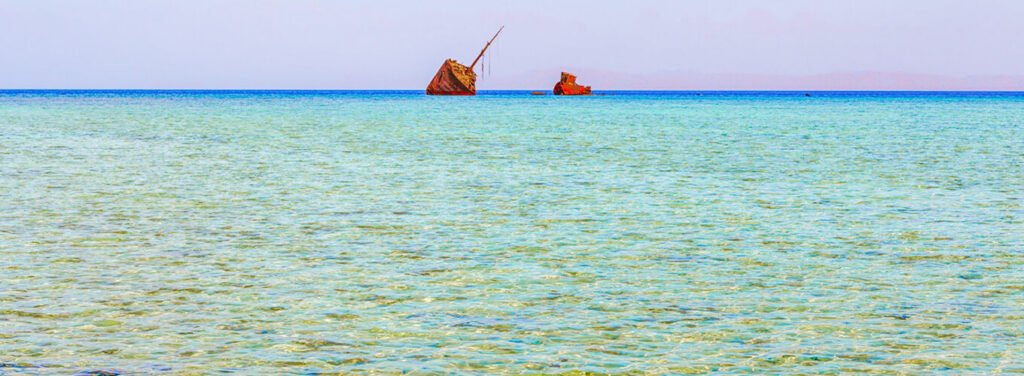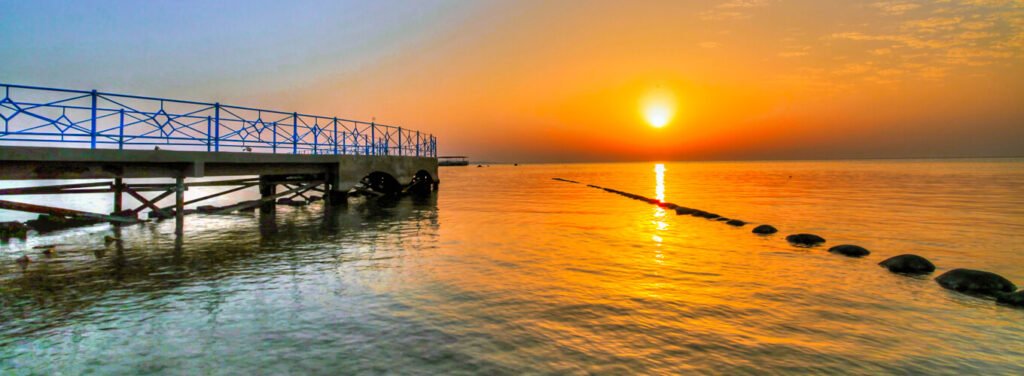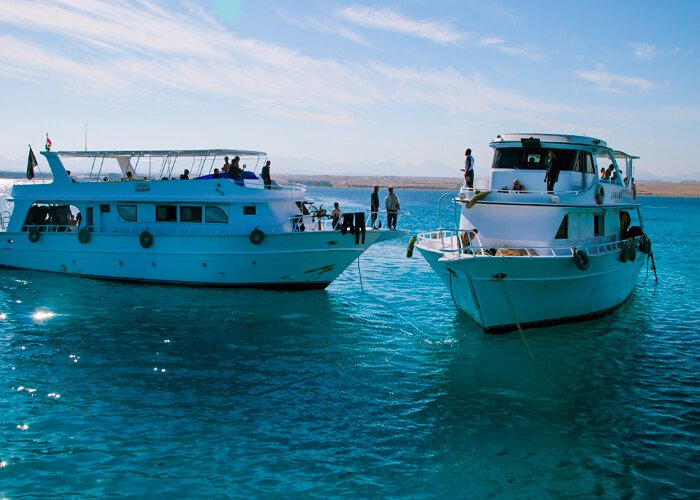Egypt Red Sea
Egypt Red Sea is one of the most mesmerizing destinations on Earth — a place where golden deserts meet crystal-clear waters, coral gardens stretch endlessly beneath the surface, and ancient legends still whisper through the waves. Stretching between Africa and Asia, the Red Sea holds a unique charm that attracts divers, historians, and travelers seeking both relaxation and adventure.
If you’ve ever wondered “where is the Red Sea?” — it lies along Egypt’s eastern border, connecting the Suez Canal in the north to the Bab el Mandeb Strait in the south. This sea isn’t just a body of water; it’s a living museum of marine life, culture, and history. Many also ask, “why is it called the Red Sea?” The answer lies in the reddish-brown Trichodesmium algae that occasionally bloom on its surface, giving the water a rare tint that inspired its name.
From Hurghada and Sharm El Sheikh to Marsa Alam and Dahab, Egypt’s Red Sea coast is dotted with world-famous resorts that offer luxury and adventure in equal measure. Whether you’re diving among vibrant corals, exploring shipwrecks, or relaxing on serene beaches, the Red Sea offers an experience that feels almost mythical. It’s no surprise that this region has become a magnet for travelers from around the world — not only for its beauty but for its fascinating mix of history, nature, and hospitality.
The Geographic Magic – Where is the Red Sea Situated?
The Red Sea sits between northeastern Africa and the Arabian Peninsula, serving as a natural boundary between Egypt, Sudan, and Eritrea on one side, and Saudi Arabia and Yemen on the other. For Egypt, it’s a crown jewel that stretches over 2,000 kilometers of stunning coastline, creating a paradise for tourism and marine exploration.
So, where is Red Sea situated exactly in Egypt? Starting from the Gulf of Suez and the Suez Canal in the north, the coastline continues down through Ain Sokhna, Hurghada, El Quseir, Marsa Alam, and all the way to Halayeb in the far south. Each destination has its own personality — Hurghada offers bustling nightlife, Marsa Alam promises tranquility, and El Gouna mixes elegance with eco-conscious design.
Geographically, the Red Sea is one of the warmest and saltiest seas in the world. It has a length of about 2,250 kilometers and a width of up to 355 kilometers. If you’ve ever asked “how big is the Red Sea?” — it covers an area of approximately 438,000 square kilometers, making it one of the most significant marine ecosystems on the planet.
Its clear visibility, stable temperatures, and coral diversity make it one of the best diving spots in the world. The Red Sea is also a major global maritime route, linking the Mediterranean Sea through the Suez Canal to the Indian Ocean, thus playing an essential role in trade and navigation. But beyond commerce, it’s a playground for adventurers and nature lovers who come to explore the surreal beauty beneath its waves.
The History and Legends – Who Parted the Red Sea?

No story about the Red Sea is complete without mentioning one of the most famous historical events associated with it — the parting of the sea. According to religious tradition, it was Moses who parted the Red Sea, allowing the Israelites to escape from Egypt and the pursuing Pharaoh’s army. This miraculous event is described in the Book of Exodus and remains one of the most iconic moments in religious history.
While historians and scientists have debated how this event might have occurred — some suggesting natural explanations like tides or wind patterns — its symbolic significance endures. For many travelers, the Red Sea holds deep spiritual meaning. Standing on its shores, one can’t help but imagine the power and drama of that moment thousands of years ago.
Today, the region that once witnessed these ancient tales is now filled with modern resorts and dive centers. Yet, beneath the surface, the sense of wonder remains. The Red Sea continues to bridge past and present — a place where sacred history and natural beauty coexist.
This historical connection is one reason why the Red Sea in Egypt is not just another travel destination. It’s a destination that tells a story — a story of miracles, exploration, and enduring faith.
Why is it Called the Red Sea? The Mystery Behind Its Name
Travelers often ask, “why is it called the Red Sea?” or “why is the Red Sea called the Red Sea?” The answer is both scientific and historical. The most accepted theory links the name to the seasonal blooms of a reddish-brown algae known as Trichodesmium erythraeum, which gives parts of the sea a rusty hue. Another explanation suggests that the term “Red” refers to the direction south in ancient Asian languages, as colors were used symbolically to describe directions — with “black” for north, “red” for south, and “white” for west.
In reality, when you visit, the Red Sea’s waters are crystal blue, not red. Its name adds to its mystique, blending natural phenomena with ancient linguistic traditions. Some historical texts even suggest that early travelers used “Red Sea” to distinguish this area from the “Black Sea” to the north.
Despite the mystery of its name, what makes the Red Sea special is its life beneath the surface — over 1,200 species of fish, 200 species of coral, and countless underwater landscapes. So, while its name might come from legend or science, its real beauty is in the living color that thrives below the waves.
Hurghada: The Beating Heart of the Red Sea Governorate

One of the most iconic cities along the Red Sea is Hurghada, officially known as Hurghada Qesm Hurghada Red Sea Governorate Egypt. Once a small fishing village, it’s now one of the most visited resorts in Egypt and a gateway to the underwater world. The Hurghada Red Sea Governorate Egypt region stretches along the coast with luxury resorts, diving centers, and endless sunshine.
Hurghada is famous for its vibrant coral reefs, perfect beaches, and exciting activities — from snorkeling and diving to desert safaris and submarine tours. If you’ve heard of the tourist submarine sinks Red Sea Egypt story, it refers to one of the submarine tours that allow visitors to view the seabed without diving. These submarines usually operate safely, offering a window into the magical world of marine life.
What makes Hurghada so popular among travelers is its accessibility and diversity. Whether you’re looking for adventure or relaxation, Hurghada delivers. Its proximity to Giftun Island, world-class hotels, and lively nightlife makes it ideal for families, couples, and solo explorers. With year-round sunshine and warm waters, Hurghada remains a must-visit gem on Egypt’s Red Sea coast.
Marsa Alam and El Quseir – The Hidden Treasures of Southern Egypt
Further south along the Red Sea lies Marsa Alam, a tranquil haven for nature lovers. Unlike the busier resorts up north, Marsa Alam offers untouched beauty — long stretches of golden sand, turquoise lagoons, and coral reefs teeming with marine life.
This area is a diver’s dream. The reefs of Elphinstone and Abu Dabbab are famous worldwide for encounters with sea turtles, dolphins, and sometimes even hammerhead sharks. Marsa Alam is also where eco-resorts blend luxury with sustainability, offering a peaceful retreat away from crowded tourist zones.
Nearby El Quseir adds a touch of history to the region. Once an important port during the Pharaonic and Roman periods, El Quseir today is a charming coastal town where old meets new. Cobblestone streets, historic forts, and welcoming locals make it a delightful stop for travelers exploring the Red Sea in Egypt.
These southern destinations represent the soul of the Egyptian Red Sea — less commercialized, more authentic, and perfect for those seeking tranquility amid breathtaking nature.
Sharm El Sheikh and Dahab – Adventure and Spirituality on the Sinai Coast

Across the Gulf of Suez lies the Sinai Peninsula, home to Sharm El Sheikh and Dahab, two of the most beloved destinations along the Red Sea. Sharm El Sheikh is known for its luxurious resorts, coral reefs, and thrilling water sports. The Ras Mohammed National Park is a diver’s paradise, offering some of the clearest waters and most vibrant coral formations in the world.
Dahab, on the other hand, captures a completely different vibe — laid-back, spiritual, and artistic. Once a Bedouin fishing village, it’s now a hub for backpackers, divers, and yoga enthusiasts. The famous Blue Hole, one of the world’s most challenging diving sites, lies just north of Dahab.
These two cities combine adventure with culture. Visitors can dive, hike Mount Sinai, or simply enjoy local cuisine along the shore. Together, they represent the diversity of the Red Sea experience — where luxury and simplicity coexist under the same sun.
Marine Life and Diving – The Underwater World of the Red Sea
If there’s one thing that truly defines the Red Sea, it’s the astonishing diversity of its marine ecosystem. Stretching over 2,000 kilometers, the coral reefs here are among the oldest and most vibrant in the world. Divers often describe it as “swimming in a living aquarium.”
The Red Sea is home to more than 1,200 fish species, many of which are found nowhere else on Earth. From colorful clownfish to majestic manta rays, from gentle dolphins to shy seahorses — every dive reveals something extraordinary. The sea’s warm temperature, averaging 26°C year-round, ensures that marine life thrives in abundance.
However, not all encounters are friendly. Stories like the tiger shark Red Sea Egypt tourist eaten incident remind travelers to respect nature and follow safety guidelines. While such occurrences are extremely rare, they underline the importance of preserving this delicate ecosystem.
For those who prefer to stay dry, glass-bottom boat tours, snorkeling trips, and underwater observatories offer breathtaking glimpses of this aquatic paradise. Whether you’re an experienced diver or a first-time snorkeler, the Red Sea never disappoints.
Activities Beyond the Beach – Desert Safaris, Culture, and Relaxation
The Red Sea coast offers much more than sea and sand. Beyond the resorts lie deserts filled with adventure — quad biking, camel rides, and Bedouin dinners under star-filled skies. Many travelers combine their beach holidays with cultural excursions to Luxor, Aswan, or Cairo, all accessible via short flights or day trips.
Luxury spas, yoga retreats, and eco-lodges are also becoming popular among travelers who seek holistic relaxation. Meanwhile, for thrill-seekers, windsurfing, kiteboarding, and parasailing remain favorite activities along windy stretches of the coast.
The Red Sea’s charm lies in its versatility. Whether you’re traveling as a family, a couple, or a solo explorer, there’s something for everyone — relaxation, culture, and excitement in one place.
Environmental Awareness – Preserving Egypt’s Red Sea Beauty
As tourism grows, protecting the Red Sea’s fragile ecosystem becomes more important than ever. Coral reefs are highly sensitive to pollution, overfishing, and irresponsible diving. Egypt has made significant efforts to protect its marine environment through national parks, strict diving regulations, and awareness campaigns.
Visitors play a crucial role too — by choosing eco-friendly resorts, avoiding single-use plastics, and following sustainable diving practices. Local authorities and NGOs continue to promote conservation, ensuring that the Red Sea’s treasures remain for future generations to explore.
Sustainability has become part of the region’s identity, balancing economic growth with environmental care. The Red Sea’s story is not only about beauty but also about responsibility.
Planning Your Trip – Red Sea Map, Tips, and Best Time to Visit

Before you pack your bags, it’s helpful to check a Red Sea map to plan your route. The northern resorts like Ain Sokhna and Hurghada are ideal for quick getaways, while the southern ones like Marsa Alam and El Quseir offer peace and seclusion. The Sinai destinations — Sharm El Sheikh and Dahab — combine adventure with cultural depth.
The best time to visit is between October and April, when the weather is pleasantly warm but not overly hot. However, the Red Sea enjoys sunshine year-round, making it perfect for diving in any season.
When organizing trips, consider booking through licensed travel agencies that specialize in Red Sea tours. They can arrange airport transfers, hotel stays, diving excursions, and desert adventures — ensuring a smooth experience from start to finish.
Whether you want to explore where is the Red Sea, learn why is it called the Red Sea, or simply relax by its shimmering waters, Egypt’s Red Sea coast offers an unforgettable blend of nature, culture, and comfort.
Conclusion: Egypt’s Red Sea – Where Every Journey Feels Timeless
From ancient legends to modern luxury, from coral gardens to golden sands — the Egypt Red Sea is more than a destination; it’s a feeling, a memory waiting to be created. Travelers come seeking beauty, adventure, and peace, and leave with stories that last a lifetime.
This is where history meets harmony, and every sunrise over the water feels like a new beginning. Whether you come to dive, to rest, or to explore — the Red Sea in Egypt will always welcome you with open arms and infinite blue horizons.




Comments are closed